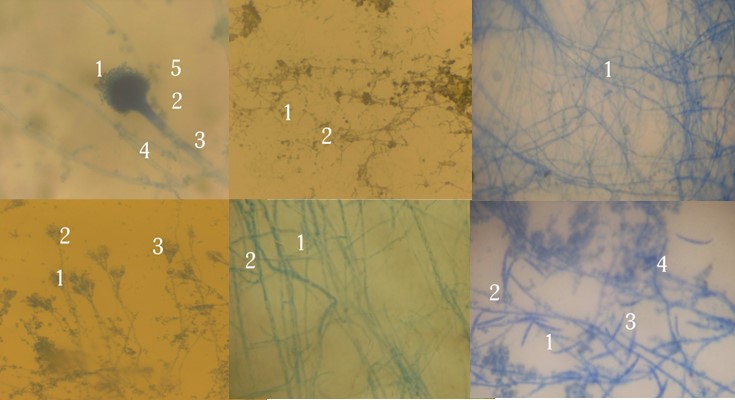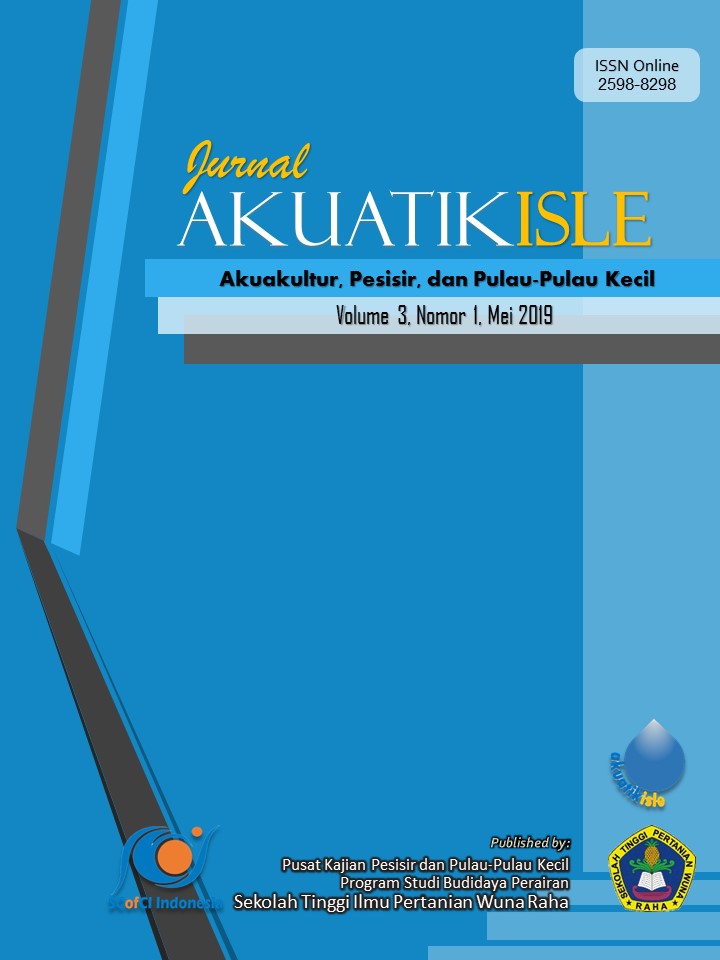Akuatikisle: Jurnal Akuakultur, Pesisir dan Pulau-Pulau Kecil
Full Length Article
Analysis and identification of Pseudomonas sp. and molds on dried anchovy (Stelophorus sp) products produced by the people of Toniku Village, Halmahera Barat Regency, North Maluku Province
Highlights
Generate NLP AI by Wizdam ID.
Abstract
This research was conducted to determine the characteristics of Pseudomonas sp. and mold on dried anchovies. The sample in this study was obtained from the fishing community of Toniku Village, West Halmahera Regency, North Maluku Province. The stages carried out in this study were 3 (three) stages, namely the sample preparation stage, the analysis phase and the identification stage of Pseudomonas sp. and mold. The results showed that the characteristics of the Total Plate Count (TPC) of dried anchovy in the Toniku Village obtained a different composition from each other, with the highest log Total Plate Count (TPC) obtained, namely 5.5 or 3.2 x 105 Cfu/g or 320.000 cells bacteria, while the lowest Total Plate Count (TPC) log was obtained, 2.5 or 3.1 x 102 Cfu/g or 310 bacterial cells and for total Pseudomonas bacteria from the three sampling locations no growth was found. The highest total log fungi were obtained ie 5.6 or 3.7 x 105 Cfu/g or 370.000 mold cells, while the lowest total log fungi were obtained which were 2.4 or 2.6 x 102 Cfu/g or 260 mold cells
Keywords
Introduction
Section snippets
Material and Methods
Materials and methods from the full-text PDF of this article cannot be displayed.
Results
Results from the full-text PDF of this article cannot be displayed.
Discussion
Discussion from the full-text PDF of this article cannot be displayed.
Conclusions
Conclusions from the full-text PDF of this article cannot be displayed.
Acknowledgment
Acknowledgment from the full-text PDF of this article cannot be displayed.
Funding Information
Kementerian Riset, Teknologi, dan Pendidikan Tinggi
Competing interest
The authors declare that they have no known competing financial interests or personal relationships that could have appeared to influence the work reported in this paper.
Conflict of interest
The authors declare that the research was conducted in the absence of any commercial or financial relationships that could be construed as a potential conflict of interest.
Ethical approval acknowledgements
No ethical approval required for this article. All procedures followed were in accordance with the ethical standards of the responsible committee on human experimentation (institutional and national) and with the Helsinki Declaration of 1975, as revised in 2008 (5)
Supplementary files
Data sharing not applicable to this article as no datasets were generated or analysed during the current study, and/or contains supplementary material, which is available to authorized users.
References (1)
Adawyah, R. 2007. Pengolahan dan Pengawetan Ikan. Penerbit PT Bumi Aksara. Jakarta
Afrianto, E., & E. Liviawaty., 1989. Pengawetan dan Pengolahan Ikan. Kanisius. Yogyakarta.
Anonim, 2006. Mikrobiologi bahan pangan. http:www. image. Mikrobiologi [Diakses Juli 2015].
Astawan, M. 2001. Penggunaan dan Pengolahan Hasil Perikanan. Penerbit Universitas Terbuka, Departemen Pendidikan Nasional (Depdiknas). Jakarta.
Atlas & Park. 1993. Handbook of Microbiologycal Media. CRC Press. Inc. New York.
Berhimpon S. 1993. Mikrobiologi Pangan Ikan Bagian I, Ekologi dan Pertumbuhan Mikroba serta Pertumbuhan Biokimia Pangan. Fakultas Perikanan dan Ilmu Kelautan. Universitas Sam Ratulangi (UNSRAT) Manado.
Cappucino JG, & Sherman N. 1992. Microbiology A. Laboratory Manual. Third Editon the Edition the Benjamin New York.
[DKP] Dinas Kelautan dan Perikanan. 2009. Laporan Statistik Perikanan Tangkap. Ternate : Dinas Kelautan dan Perikanan Provinsi Maluku Utara.
[DJP] Direktorat Jendral Perikanan. 1981. Pembuatan ikan asin. Balai Besar Penelitian dan Pengembangan Industri Hasil Perikanan. Publikasi No.4.
Dwidjoseputro D. 1989. Dasar-dasar Mikrobiologi. Anggota IKAPI. Penerbit Djambatan. Jakarta.
Fardiaz, S. 1993. Mikrobiologi Pangan. Penuntun Praktek Laboratorium. Jurusan Teknologi Pangan dan Gizi, Fakultas Teknologi Pertanian, Institut Pertanian Bogor (IPB).
Gandjar, I. 1999. Pengenalan kapang tropik umum. Yayasan Obor Indonesia.
Hidayat NS, Suhartini, & Padaga MC. 2006. Mikrobiologi Industri. Penerbit CV. Andi Yogyakarta.
Ijong FG. 1996. Penuntun Praktikum di Laboratorium. Fakultas Perikanan dan Ilmu Kelautan. Universitas Sam Ratulangi (UNSRAT) Manado.
Irawan, 1997. Pengawetan Ikan dan Hasil Perikanan. Cara Mengelolah dan Mengawetkan Secara Tradisional dan Modern. Penerbit Aneka Ilmu. Solo.
Kurosawa A. 2003. Teknologi Pengolahan Ikan di Indonesia. Penerbit Departemen Kelautan dan Perikanan. Jakarta.
Moeljanto, 1982. Penggaraman dan Pengeringan Ikan. Penerbit PT. Penebar Swadaya. Jakarta.
Moeljanto, 1992. Pengolahan dan Pengawetan Hasil Perikanan. Penebar Swadaya. Jakarta.
Novarisa, 2010. Studi kadar air hasil pengeringan mutu ikan teri kering yang dihasilkan. Jurnal Penelitian, Fakultas Teknologi Pertnian Universitas Andalas, Padang.
Opstvedt, J. 1988. Influence of Drying and Smoking on Protein Quality in J.R. Burt (Ed.) Fish Smoking and Drying : The Effect of Smoking and Drying on The Nutritional Properties of Fish. Elsevier Applied Science, London.
Pelczaer MJ, & E.C.S. Chan. 2005. Dasar-dasar Mikrobiologi. Penerbit Universitas Indonesia.
[SNI] Standar Nasional Indonesia. 2006. SNI : 01-2718-2006. Persyaratan Mutu Ikan Asin Kering. Badan Standarisasi Nasional Indonesia.
Supardi I, & Sukamto M. 1999. Mikrobiologi dalam Pengolahan dan Keamanan Pangan. Penerbit Alumni. Bandung.
Syahrurachman ML. 1994. Buku Ajar Mikrobiologi Kedokteran (Edisi revisi), Staf Pengajar Fakultas Kedokteran Universitas Indonesia. Penerbit Bina Aksara. Jakarta.
Volk, WA & MF. Wheeler. 1993. Mikrobiologi Dasar. Jilid I. Edisi kelima. Penerbit Erlangga. Jakarta.
Waluyo L. 2004. Mikrobiologi Umum. Penerbit Universitas Muhammadiyah Malang.
Winarno, FG. Fardiaz S, & Fardiaz D. 1993. Indonesian Fermented Food Lecture Presented to Regional Graduate Nutrition Course. Bogor: Southeast Asia Minister of Education Organization (SEAMEO) Bogor Agricultural University.Bibliographic Information
Cite this article as:
-
Submitted
10 June 2018 -
Revised
27 December 2018 -
Accepted
8 May 2019 -
Published
10 May 2019 -
Version of record
5 December 2020 -
Issue date
31 May 2019
-
Academic subject
Aquaculture; Fisheries Science
Keywords
Copyright
Sangia Advertisement
Copyright © 2019 Ruslan A. Daeng, Azis Husen. Sangia Research Media and Publishing. Production and hosting by Sangia (SRM™).  This work is licensed under a Creative Commons Attribution-ShareAlike 4.0 International License.
This work is licensed under a Creative Commons Attribution-ShareAlike 4.0 International License.
Disclaimer: All claims expressed in this article are solely those of the authors and do not necessarily represent those of their affiliated organizations, or those of the publisher, the editors and the reviewers. Any product that may be evaluated in this article or claim that may be made by its manufacturer is not guaranteed or endorsed by the publisher.
Comments on this article
By submitting a comment you agree to abide by our Terms and Community Guidelines. If you find something abusive or that does not comply with our terms or guidelines please flag it as inappropriate.










